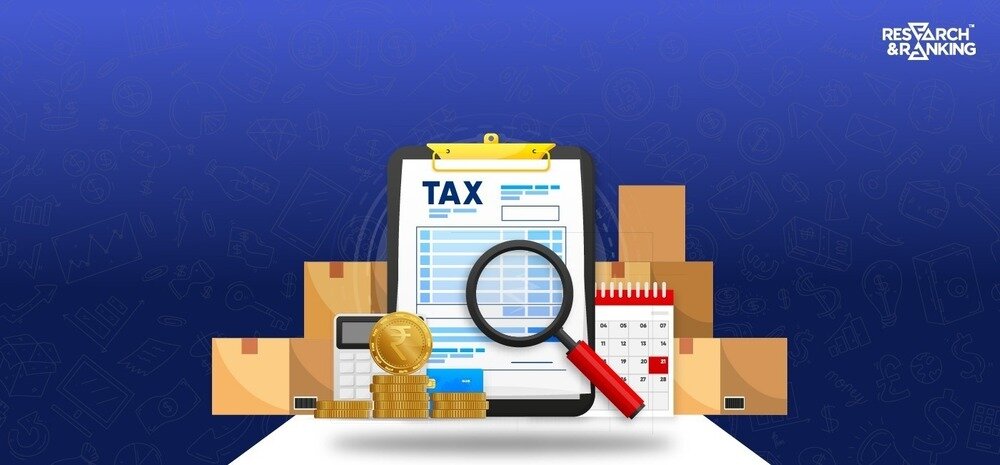Have you ever wondered what the multiple tax deductions under your restaurant bill indicate? Want to know what additional taxes are added to your new phone bill?
India’s tax structure is bifurcated into direct and indirect taxes, each playing a pivotal role in the country’s economic framework. Among these, indirect tax is a substantial part of the government’s revenue and directly impacts the everyday consumer.
This blog delves into the nuances of indirect taxation in India, exploring its features, benefits, and the list of indirect taxes prevalent in the country.
What is Indirect Tax?
Unlike direct taxes, where the tax is levied on income or assets, and the burden falls directly on the taxpayer,, indirect taxes are levied on the sale, purchase, or consumption of goods and services. This means the tax burden is shifted from the taxpayer to the consumer.
The concept of indirect tax involves collection by an intermediary (such as a retailer or a manufacturer) from the person who bears the ultimate economic burden of the tax (such as the consumer).
An indirect tax results in higher prices of goods and services at the time of purchase. Indirect tax is thus an additional charge included in the maximum retail price of a particular product or service.
Example:
A common example of indirect tax is GST. Say you went out to eat, and your bill amounted to ₹5,000 plus a GST rate of 5%. In this case, you will have to pay ₹5,000 plus 5% of ₹5,000.
So your total bill would be ₹5,000 + ₹250 = ₹5,250.
The additional ₹250 that you pay is the indirect tax passed on to you (the consumer) by the service provider.
You can also learn about the tax concepts with our blog.
Features and Benefits of Indirect Taxation in India
Indirect taxes have several key features and benefits that make them an integral part of India’s tax ecosystem:
- Broad-based: Since these taxes are levied on goods and services, they have a wide base, covering almost all economic activities and transactions.
- Convenience: The collection process is straightforward since the tax is included in the price of goods and services, making it easier for the government to collect.
- Transparent: The final prices of goods and services are inclusive of indirect taxation. This allows complete transparency during filing and returns.
- Non-evasible: It is difficult to evade indirect taxes because they are built into the transaction process.
- Revenue generation: Indirect taxes are a significant source of revenue for the government, funding various public services and infrastructure projects.
- Uniform: GST has three main components: CST (Central GST), SGST (State GST), and IGST (Integrated GST). These have helped to replace the plethora of indirect taxes that were present pre-GST.
This uniformity allows for the majority of goods and services to be bought at the same price, with a few exceptions like petrol and diesel, which are still considered under VAT (Value-Added Tax), central excise duty, and central sales tax.
List of Indirect Taxes in India
The list of indirect taxes in India has been simplified and consolidated under the Goods and Services Tax (GST) regime.
However, there are still a few other indirect taxes outside the GST framework.
Also Read: Top 10 Stock Market Movies to Watch
What is Goods and Services Tax (GST)?
Introduced in July 2017, GST is levied on every value addition. A destination-based, multi-stage, comprehensive indirect tax, GST amalgamated several former taxes and levies, including value-added tax (VAT), service tax, excise duty, etc., into a single tax system.
GST is applied to the supply of goods and services and aims to eliminate the cascading effect of taxes, thereby making the tax structure more efficient and business-friendly.
The slabs within GST remain uniform, regardless of the state, and are categorized into State GST, Central GST, Interstate GST, and Union Territory GST.
. The various tax slabs within GST for goods are as follows.
| GST Slabs for Goods | Explanations |
| Nil Rate | Livestock, live fish and animal products like the meat of bovine animals, bird eggs (fresh, preserved or cooked), bones and horn-coresAll goods that are fresh or chilled that are not pre-packaged/labelled.Dairy products like fresh milk, cream, curd, buttermilk, Chena/ paneer, etc.Natural honey that isn’t pre-packaged/labelled.Live trees and fresh produce, dried produce not further prepared, nuts, seeds and grains that aren’t pre-packaged/labelled.Flours and cereals that aren’t pre-packaged/labelled; salt, bread, Pappad, Water (that isn’t aerated, mineral or otherwise sold on a sealed container) All types of contraceptives, Human Blood, Municipal and clinical wasteDeities made of stone, marble or woodRupee notes or coins sold to the Reserve Bank of India or the government of India |
| 5% | Railways – transport of goods and passengers Imported goodsRenting a motor cab without fuel costAC transport services – contract/stage or radio taxiAir transportTour operator servicesLeasing of aircrafts Newspaper printing |
| 12% | Rail transport of goods from a third party other than Indian RailwaysAir travel excluding economyTour operator servicesFood/drinks charges at restaurants without AC/heating or liquor licenseRenting of rooms/accommodation between ₹1000 and ₹2500 per dayChit fund services by foremenLeasing of aircraftsConstruction of property for the purpose of saleTemporary intellectual property rights |
| 18% | Food/drinks charges at restaurants with liquor license, and/or AC/heating, outdoor catering Renting of rooms ranging between ₹2500 and ₹5000 per daySupply of food, shamiyana, and party arrangementTickets to the circus, Indian classical, folk, theatre, dramaSupply of work contractsMovie Tickets over ₹100Hotel accommodation for per day transactions of ₹2,500 – ₹7,500 |
| 28% | Tickets to entertainment events, amusement/theme parks, water parks, films, race courses, joy rides, go-carting, ballet, casinos, and sporting events like IPLRace club servicesGambling services Accomodations and/or Food/drinks charges at AC 5-star hotels (or above)Hotel accommodation valued ₹7501 or more per unit per day e |
The GST slab for services is at a fixed rate of 18% for services provided by:
- Legal professionals,
- Chartered accountants, company secretaries and cost accountants
- Doctors and dentists
- Engineers and IT professionals/services like Internet Telecommunications Services, Maintenance, Repair and Installation Services and other similar IT services.
- Architects and interior decorators/ designers
- Teachers and private tutors (who run coaching centers)
- Fashion designers and film artists
- Courier services, including transportation, collection and delivery services
- Training services by commercial coaching entities; Educational events by foreign organizations in India
- Loans such as personal loans, home loans, and car loans
Other Indirect Taxes in India
The list of indirect taxes before GST was introduced included Value Added Tax (VAT), sales tax, service tax, stamp duty, etc.
Even though most of the indirect taxes are now absorbed by GST, a few indirect taxes remain outside its purview:
- Service Tax – This indirect tax applies to all the services offered to the consumers.
- Customs Duty: Levied on imports and exports of goods, customs duty is a significant part of India’s indirect tax landscape. It helps regulate the movement of goods across international borders and protects domestic industries.
- Excise Duty: Specific goods manufactured in India, mainly petroleum and alcohol for human consumption, are still subject to excise duty, as these items are outside the GST regime.
Implications of the Concept of Indirect Taxes in India
Indirect taxes have wide-ranging implications for both businesses and consumers:
- Price Alteration: The inclusion of taxes in the cost of goods and services directly affects their price, potentially leading to inflationary pressures.
- Consumption Behavior: High taxes on certain goods (like tobacco or luxury items) can deter consumption, aligning with government policies on public health and the environment.
- Business Compliance: The GST regime, while simplifying the tax landscape, requires businesses to adhere to detailed compliance and filing procedures, impacting their operations.
Conclusion
Indirect taxation in India plays a crucial role in shaping the economy, influencing consumer behavior, and driving government policy. The transition to the GST regime marked a significant overhaul of the indirect tax structure, aiming for a more unified and efficient tax system.
The concept of indirect taxes is an indispensable part of India’s fiscal policy, affecting every layer of the economic stratum. Understanding what an indirect tax is, its applications and its implications can help demystify how government policies trickle down to affect everyday prices and the broader economic landscape.
To reduce your tax liability, you must learn how to pay less tax via permitted deductions and exemptions in income tax.
For example, frequent overseas travellers can use forex cards to reduce taxes since they do not have to pay TCS on forex cards if they spend within ₹7 lakhs in a financial year. Forex cards with zero to low markups are a great choice for these cases.
Another common way is by investing in stocks and bonds. If you are unsure how to proceed with choosing and buying the right bond and stocks, you can consult a share market advisory. Their portfolio management services and constant monitoring of stocks help ensure you are updated on your purchased stocks.
Frequently Asked Questions Indirect Tax in India
How is GST different from previous indirect taxes?
GST merges multiple indirect taxes into one, reducing the cascading effect of taxes and simplifying compliance, thereby making the tax system more transparent and business-friendly.
Can indirect taxes affect economic growth?
Yes, indirect taxes can influence economic growth. By adjusting the rate and scope of indirect taxes, the government can impact consumer spending, investment, and overall economic activity.
Are all goods and services taxed under GST?
Most goods and services are taxed under GST. Still, there are exceptions, including alcohol for human consumption, petroleum products, and certain state-specific utilities, which are taxed under different indirect tax structures.
What is Net Indirect Tax?
Net indirect tax refers to the total indirect taxes levied by the government on goods and services minus the subsidies provided.
How useful was this post?
Click on a star to rate it!
Average rating 1 / 5. Vote count: 1
No votes so far! Be the first to rate this post.
I’m Archana R. Chettiar, an experienced content creator with
an affinity for writing on personal finance and other financial content. I
love to write on equity investing, retirement, managing money, and more.
























